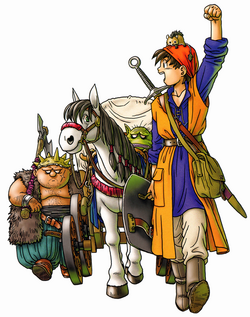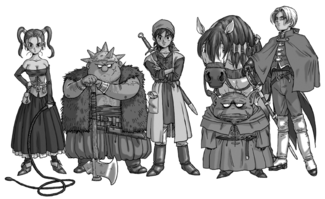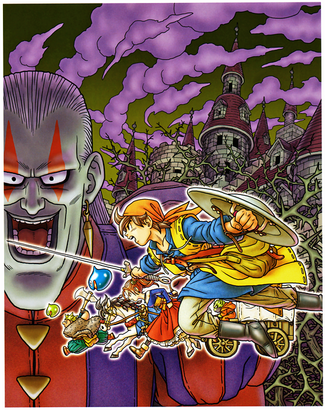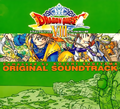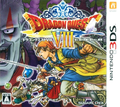Dragon Quest VIII: Journey of the Cursed King
| Main series games | |
|---|---|
| Journey of the Cursed King | |
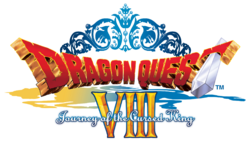 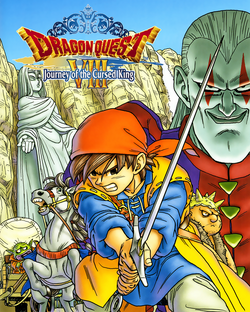
| |
| Developer(s) | Level-5 |
| Publisher(s) | Square Enix |
| Designer(s) | Yuji Horii |
| Artist(s) | Akira Toriyama |
| Composer(s) | Kōichi Sugiyama |
| Series | Dragon Quest |
| Aspect ratio | 16:9 / 4:3 |
| Native resolution | 480i (SDTV) |
| Platform(s) | PlayStation 2 Nintendo 3DS |
| Release date(s) | JP November 27, 2004 NA November 15, 2005 AUS April 12, 2006 EU April 13, 2006 JP December 12, 2013 (mobile) NA May 29th, 2014 (mobile) EU May 29th, 2014 (mobile) JP August 27, 2015 (3DS) NA January 20, 2017 (3DS) EU January 20, 2017 (3DS) |
| Genre(s) | Console role-playing game |
| Mode(s) | Single-player |
| Rating(s) | CERO: All ages ESRB: T (Teen) OFLC: PG PEGI: 12+ USK: 6 |
| Media | DVD |
| Input methods | DualShock 2 |
Dragon Quest VIII (ドラゴンクエストVIII 空と海と大地と呪われし姫君 Dragon Quest VIII Sora to Umi to Daichi to Norowareshi Himegimi, Dragon Quest VIII: The Sky, the Ocean, the Earth, and the Cursed Princess) is the eighth installment in the Dragon Quest series, developed by Level-5 and published by Square Enix for the PlayStation 2 video game console. It was also later released for the Nintendo 3DS in 2015.
Plot
Characters
Playable Characters
- Hero - The Hero is a royal guard of Trodain, who journeys with King Trode to hunt down Dhoulmagus and make him pay for his crimes. His pet mouse, Munchie, usually rides in his right coat pocket.
- Yangus - Yangus is a former bandit who journeys with the Hero and King Trode. Like the Hero, he is a party member from the start of the game.
- Jessica Albert - A voluptuous, short-tempered, and tomboyish sorceress born to a wealthy family in the town of Alexandria, and the third party member. She seeks to avenge her brother Alistair, who is slain by Dhoulmagus.
- Angelo - Angelo is one of Maella Abbey's Templar Knights and the fourth party member. Though unable to live with the strict moral code of the Templars, with his lust for gambling and women, he is faithfully devoted to Abbot Francisco.
Other Characters
- King Trode - King Trode is the King of Trodain, and the titular character of Dragon Quest VIII: Journey of the Cursed King. He was transformed into a toad-like creature by the evil wizard Dhoulmagus, and is trying to find a way to lift the curse upon him. During parts of the game, if you press the Select button, King Trode will give you helpful advice.
- Princess Medea - Medea is the daughter of King Trode. She was turned into a horse when her father was cursed by Dhoulmagus. She travels with the party by pulling the cart with their supplies. She and the Hero are close childhood friends.
- Marcello - Marcello is the captain of the Templar Knights who guard the Abbot with their lives. However, Marcello wants more power than was offered, and after he takes over following the Abbot's death, he becomes a partner to High Priest Rolo. With this opening, the resulting events that Marcello causes will set the stage for the fate of the world to be decided.
- Sir Leopold - He is the spoiled dog of the great magician Dominico. Leopold is let out of his cage by the mistake of a servant, and after the previous wielder of the Sceptre drops it, Leopold picks it up and is taken over by Rhapthorne.
- Dhoulmagus - Dhoulmagus is a jester who, in order to get revenge on those who insulted him, stole a magical sceptre from Trodain Castle. However, when he attempted to unleash its power, it overwhelmed him, and allowed Rhapthorne to take over his body.
- Lord Rhapthorne - Lord Rhapthorne is the main antagonist who is heard, but isn't seen until the end of the game. His spirit was trapped in the Trodain sceptre that Dhoulmagus possessed in the beginning of the game. Lord Rhapthorne took control of whoever possessed the sceptre which was first Dhoulmagus, then Jessica, then a fearsome pet dog named Sir Leopold until he killed each heir of the seven sages to release his energy and give himself his own body.
- Red - Red is a thief who was an old mate of Yangus. She is interested in old, precious treasures. In the 3DS version, she joins the party in hopes of finding valuable loot after being disappointed by a certain pirate's treasure.
- Morrie Mozzarella - Morrie is a mysterious, energetic older gentleman who runs the Monster Arena known as Morrie's Place. On 3DS, he is the sole optional party member. He can join the group if the Hero manages to impress him, beating Rank S.
New Features
Player conveniences
- Random encounters are suppressed as long as the party is on a road.
- There is an automap feature in dungeons, and complete maps of all towns. The locations and contents of chests are marked on the map. Also, it is possible to browse the inventory of the shops while looking at the town map.
- Party conversations return from the previous installment, but it is now possible to either select which party member to talk to, or cycle through them in order.
- All items now have specific icons and illustrations, which can be viewed in the menu.
- The player can now select how long they wish to stay at an Inn, changing the time of day.
- In the event of a full party wipe out, all characters are automatically revived at the last church the game was saved at.
Battle refinements
- Individual monsters within groups can now be targeted.
- Wisdom now improves the power of offensive spells, addressing the infamous schism between the usefulness of magic and skills in VI and VII.
- A new command has been added to the battle menu, Intimidate. The purpose of this option is to end battles quickly by driving monsters off, and each terrorized beast still has a chance to drop an item. Success is dependent on the lead character's level against the monster's, even if a character not in the lead is shown doing the intimidating.
Alchemy
At a certain point in the early game, the party receives an Alchemy Pot. This device can be used to combine two items into a third (usually more powerful) item following various Alchemy recipes. The combination takes a certain amount of time, depending on the power of the combined item and the level of the pot. This "time" only advances as the wagon moves, on the overworld. Later in the game, the pot is upgraded to hold three items, allowing additional, even more powerful recipes.
An invalid recipe will be rejected immediately without consuming the items, allowing the player to experiment to find new recipes. In the bonus dungeon, the player gains a pot that can mix items instantly.
New recipes (or clues to new recipes) are revealed in various books and scraps of paper found throughout the game. All recipes the player has discovered are listed in a "recipe book" accessed through the alchemy menu; recipes which are only partially known (from a clue) will have some item names replaced with "????."
Skill system
In addition to learning spells when reaching a certain level, characters are now able to attain new abilities by allocating skill points into one of five categories. The types of skills are the character's three favored weapon, unarmed combat, and the character's innate personality. Skill points are awarded upon leveling up, or when using a Seed of skill], and must be used immediately or the menu will not close.
Because skills are now tied to specific weapon groups, only the abilities learned by developing a character's personality can be used at any time--all other skills are locked to that specific type of weapon. For example, Jessica may use Puff-Puff if she is equipped with a Whip, but not Sudden Death.
Tension system
There is a new Dragon Ball-inspired tension system, allowing combatants to spend a turn building up "tension," which will increase the power level of their next attack or spell. Tension can be built up repeatedly, increasing attack power by up to seven times. There is a new party AI option to focus on using high-tension attacks, replacing the old "Leave it to me" option. Attempting to reach the fourth, "super-high tension" state has a 2/3rds chance of failure. Also, some monsters are able to instantly reach the third stage of tension, and will then repeatedly attempt to reach the super-high level.
Other changes
- Characters are shown holding their equipped weapons, posture changing on the type of weapon and their state of health and status. In a few cases the character's displayed clothing will change to reflect their equipment, seen most notably with Jessica's outfits.
- The battle screens are shown in a dynamic view, with shifting camera angles to display the current combatant and the action being performed. The party appears in the battle screen, unlike previous installments. At the end of the battle, an animation of the surviving party members putting away their weapons is played.
- The buildings in a town are visible even from the overworld view.
- The Day-night cycle of games III, IV, and V is restored. Time now passes even in towns, and the party can use an inn to switch from day to night, as well as vice-versa. Thus, there is no longer a Night light, or related spells.
- Style has been removed.
- Characters cannot be renamed.
- Vehicles are shown at their actual size, and the world map is scaled down appropriately when they are in use. The ship has a bridge which it uses to dock with the land, and its altitude can be changed to match the shorter cliffs, if necessary.
- A Sabrecat steed replaces the traditional Flying Carpet, and is unlocked via a sidequest at Chateau Felix. It moves much faster than the Hero, allowing the party to move further between random encounters (although they still occur at the same rate).
- Although the party has a wagon throughout the game, it has no effect on gameplay other than housing the Alchemy Pot, since the party is essentially fixed throughout the game. Also, it is not normally shown on the display, only appearing during cutscenes or the Party Chat screen.
Development
Dragon Quest VIII's designers include Yuji Horii as scenario director, Akira Toriyama as the art designer, Kōichi Sugiyama as the music composer, and the company Level-5 handling development.
Preliminary development began 2001, with Sony's recently released PlayStation 2 console being considered a logical choice thanks to its breakout sales figures and the popularity of the previous iteration of hardware. Troubled by the rough development period of the previous game and its mixed reception from fans, as well as the drastic changes taking place in the industry during the shift to the sixth generation of console hardware, Yuji Horii struggled to form fresh ideas for what would become the eighth game. During this time a representative of Enix, Tatsuhiro Watanabe, approached Akihiro Hino of Level-5 over the possibility of developing the next Dragon Quest, explaining that he was deeply impressed with the quality of Dark Cloud. Hino initially declined the offer, being occupied with the development of Dark Cloud 2 and feeling that such a project was beyond him at the time. However, he and Watanabe would later meet at a drinking party where Hino would list off his several complaints about Dragon Quest VII. Watanabe responded to this by stating that if he loved the series enough to have so many issues with the latest game, then why not make the next one himself? The Watanabe piqued Hino's interest further by stating that Level-5 would have to develop a working prototype to be compared against other candidates.
Hino's competitive spirit was fired up with the context of the selection process being framed as a contest, and Level-5 completed its prototype in December of 2001. When it was presented to Horii for his evaluation, he was shocked by both the quality of the demo and the strong technical understanding of the PlayStation 2 hardware the company demonstrated. Level-5 was selected as the developer of Dragon Quest VIII and Hino was appointed as the director, which caused much surprise among Japanese fans of the time as none of the company's staff had any prior involvement with the series. Regardless Hino and his staff proved themselves to be more than capable developers, with VIII being the only time that a title experienced no delays from its announcement to release.
Being developed by Level-5, with many staffers being fans of the series since their childhood, VIII is a love letter to the entire franchise. Several characters from previous Dragon Quest games make a cameo appearance, among which are the Martial Artist and Warrior from Dragon Quest III; Ragnar, Healie, and Torneko Taloon from Dragon Quest IV; There is even an allusion to the Dragonlord from Dragon Quest present. Additionally, extra care was taken to ensure that the feel of the classic titles was maintained in all aspects, such as using a stopwatch to time how long it takes for the magic sound effect to play after a spell is cast to even the time spent opening and closing the menu compared to the 8-bit titles. Level-5's prowess with the PS2 hardware also invigorated Toriyama and Sugiyama, who were able to rely on the company to realize the more detailed character designs and richer compositions they had prepared. In regards to the former, the staff watched several dozen hours of the anime adaptation of Toriyama's Dragon Ball in preparation for developing the walking, speaking, and battle animations.
Localization
Dragon Quest VIII: Journey of the Cursed King was released in North America on November 15, 2005, and shipped with a playable Final Fantasy XII demo disc. Additions and changes to the North American version of Dragon Quest VIII include: voice acting, new animations, enhanced music and sound effects, a new menu interface, and an extended ending sequence. It was also the first game in the Dragon Quest series to bear the original, Japanese "Dragon Quest" name (rather than "Dragon Warrior") in North America. Dragon Quest's North American name was changed, due to a trademark conflict with the role-playing game DragonQuest, which was published by wargame publisher Simulations Publications in the 1980s until the company's bankruptcy in 1982 and purchase by TSR, Inc., which then published it as an alternate pen-and-paper RPG line to Dungeons & Dragons until 1987.
A demo disc for Dragon Quest VIII was released in America during the fall of 2005 through certain venues, including Shonen Jump magazine. Dragon Quest VIII is also the first flagship Dragon Quest game to be released in Europe. It was released in Europe on April 13, 2006, under the title Dragon Quest: The Journey of the Cursed King, dropping the number. Unlike the North American version, the European version does not contain a Final Fantasy XII demo.
Unlike the original Japanese version, the North American and European localizations of the game include voice acting in nearly all cutscenes. The game nevertheless retains the series' tradition of allowing the player to name the lead character, avoiding issues by having the voice acting script skip all incidences of the Hero's name by use of stand-in monikers and occasionally replacing the name with Yangus' nickname for the Hero, "Guv'" (as in "governor," pronounced with a Cockney accent). Dragon Quest VIII also marks the first time that no content was censored for the international release. The English translation is credited to Plus Alpha Translations and AltJapan.
Mobile port
Square Enix released a mobile port of Dragon Quest VIII on December 12, 2013 in Japan and on May 29th, 2014 worldwide. This [[Cell phone]) was based on the original Japanese release, so it lacked some features the western fans had come to love from the original release: orchestral soundtrack, voice acting, and the more intricate interface. Some of this version's characteristics and changes compared to the Japanese PS2 version are:
- Basic phone utility changes.
- Touch control and other adaptations needed. The text boxes are much simplier and NPCs have a circular interaction area around them, for instance.
- Locked in portrait mode, cannot be played while on landscape mode.
- It's not compatible with controllers.
- Alchemy is instantaneous starting from this version. (The Dragovian reward is now 10 Super Seeds of Skill)
- Pots and barrels are destroyed on the spot.
- AI for Hero, as well as the removal of Dragon Soul
- Skill points don't need to be used immediately upon leveling up.
- Changes to certain spell and skills, like Pearly Gates using it's animation from the western PS2 release.
- Trode has been removed from the battle record screen.
- Unlike the other versions of the game, it is only available in English and French in Europe.
3DS remake
The game was remade for the Nintendo 3DS and released in Japan on August 27, 2015, and in the US and Europe on January 20, 2017.
- Two new playable characters: Red and Morrie. The former is recruited automatically at certain point in the story, while the later can be obtained after beating Rank S in the Monster Arena.
- This version has symbol encounters like most 3D Dragon Quest games released after the first Joker game. To compensate for it's technical charge, the overall draw distance for trees and other elements was reduced.
- Colors are much more saturated than on any other version.
- Like in the mobile port, alchemy is instantaneous.
- New scenarios to get more context to the Hero and Princess Medea's relationship, and Dhoulmagus's original motives.
- A button on the lower screen allows players to access a variety of useful spells and items like Zoom, Baumren's bell or the Alchemy Pot much faster.
- A side-story with Marcello and Juggerwroth. This sidestory is unlocked very near the end of the main story, and gives party some insight on one of Rhapthorne's strongest followers.
- A boss-rush type dungeon called Memories Lane, available as a reward from the Lord of the Dragovians. This dungeon contains stronger versions of most of the bosses in the game, and a familiar superboss.
- A new Monster Arena rank: Rank X. It becomes available after unlocking Morrie.
- The Japanese release has orchestral soundtrack, by the Tokyo Metropolitan Symphony Orchestra. The Western release uses midi soundtracks.
- Japanese voice acting available for the first time.
- New English lines were recorded where needed (new scenarios, changes like Red's role, etc), and Jessica's VA was replaced due to her original actress leaving the dubbing industry.
- New ending with a certain lady and some minor additional scenes leading to it were added.
- New sets of outfits for every playable character.
- The Hero keeps his bandana when going into high-tension mode, losing the super saiyan hair.
- Some of the most revealing outfits for Jessica were toned down or altered.
- Two scenes were toned down by censoring David being forced to eat dog food and Marcello no longer stabbing himself with a dagger to snap himself out of Rhapthorne's control.
- New Rarefied monsters that only appear under specific conditions, like Cherreevil blossom, Crème caraslime, or Morrimp.
- A new camera mode is available. There are several sidequests related to it, giving players rare rewards. The last few quests contain a a character from Dragon Quest IX. The game includes a limited photo editor for pictures taken with the new mode.
- There is DLC equipment in this release, most notably Erdrick's Sword.
- New items were added. With a couple of the new items, players to ride a silver and a black great sabrecats.
- Some bosses, skills and spells were re-balanced. The most notable example is the Twin Dragon Lash skill being nerfed considerably.
- Princess Minnie's rewards are expanded. Some include new weapons and even costumes.
- A Walking corpse operates a night shop in Arcadia where a [[Seed of skill] can be purchased once every 24 hours in real time.
Trivia
- VIII is the first, and so far only, entry in the main series to begin with a battle sequence. This is a response to fan criticism of VII's notoriously long prologue.
- On PS2, DQ VIII had synthesised music in Japan, and orchestral elsewhere. On 3DS, the situation was the opposite: orchestral music in Japan, and synth everywhere else.
- Angelo cannot be seen in any of the game's box artworks despite joining the party early in the game.
Credits
| Role | Staff |
|---|---|
| Scenario & game design | Yuji Horii |
| Character & monster design | Akira Toriyama |
| Music composer | Kōichi Sugiyama |
| Director | Akihiro Hino |
| Scenario staff | Jin Fujisawa |
| Atsushi Narita | |
| Amo Kamimura | |
| Shigeki Nakadera |
| Role | Staff |
|---|---|
| Programming director | Yasuhiro Akasaka |
| 3D system programmer | Kenji Matsusue |
| Main programmer | Tomohiro Misei |
| Yoichi Kawaguchi | |
| Battle system program | Takayuki Kobayashi |
| Koji Chado | |
| Mamoru Itagaki | |
| Motion systems & plug-ins | Makoto Shikasho |
| Scenario script | Masahiro Noda |
| Yoshio Fukushima | |
| Tetsu Konno | |
| Yukinori Yamaguchi | |
| Keiji Noda | |
| Naohiro Ikeda | |
| Takaharu Takesada | |
| Kiyonori Tsutsumi | |
| Kazuma Shinkawa | |
| Programming support | Usuke Kumagai |
| Character director | Jun Sonobe |
| Main character models & motion | Akiyuki Tomita |
| Sub-character design | Tomokazu Arisaka |
| Sub-character models & motion | |
| Kengo Todaka | |
| Shinya Hayakawa | |
| Chie Sasaki | |
| Hiroto Jinnouchi | |
| Akiko Shigeto | |
| Jun Suzuki | |
| Event motion | Emiko Ikeuchi |
| Takashi Hara | |
| 2D Graphics design | Noriaki Sonoda |
| Miho Tanaka | |
| Noriko Maruya | |
| Kazuyuki Koga | |
| Takahiro Koshio | |
| Yukari Fujiki | |
| Event movie arrangement | Eiji Ishii |
| Monster & effects director | Ken Motomura |
| Monster models & motion | Jun Maeda |
| Takahiro Fujimatsu | |
| Takehiro Fujii | |
| Tomoe Ueda | |
| Yoshiaki Kusuda | |
| Hiroshi Niwa | |
| Hiroshi Sawano | |
| Takayoshi Hirose | |
| Kenichi Kurakari | |
| Yuuki Kokubu | |
| Takeshi Akasaka | |
| Mineaki Sugata | |
| Effects design | Yoshiaki Kōya |
| Rika Yamashita | |
| Youhei Fujimura | |
| Mitsuhito Nakajo | |
| Art directors | Takayuki Sameshima |
| Kazunari Matsuo | |
| Original backgrounds | Shinichi Matsumoto |
| Nobuyuki Yanai | |
| Kaoru Minami | |
| Map graphics | Naoko Mori |
| Miyuki Sumiyoshi | |
| Noboru Tsuda | |
| Tadahiro Masuya | |
| Wataru Shimanouchi | |
| Akari Uchino | |
| Hisami Miyamoto | |
| Daisuke Koga | |
| Kōsuke Uemura | |
| Yasuyoshi Sasaki | |
| Tatsuya Asano | |
| Hidenobu Sasaki | |
| Kengo Okabe | |
| Yasuhito Tsugimoto | |
| Hiroshi Matsuyama | |
| Tetsuya Maeda | |
| Nahoko Kawabata | |
| Satoshi Baba | |
| Masako Arakawa | |
| Daisuke Simakawa | |
| Naotsugu Zushi | |
| Yasuhiro Fukuyama | |
| Sound effects | Dai Yamanaka |
| Sound production support | Tomohito Nishiura |
| Yumiko Hashizume | |
| Takeshi Inoue | |
| Special thanks | Takeshi Majima |
| Taku Tanaka | |
| Jiro Morinaga | |
| Keiji Nagao | |
| Koji Hori | |
| Noriko Ikeura | |
| Tatsuru Nakaza | |
| Yukiko Harada | |
| Tomoko Hirayabu | |
| Asako Fujita |
| Role | Staff |
|---|---|
| Music | Tokyo Metropolitan Symphony Orchestra, conducted by Kōichi Sugiyama |
| Music programming | Kōichi Sugiyama (SUGIYAMA KOBO) |
| Hidenori Miyanaga (TOSE) | |
| Ryoue Takagi (TOSE) | |
| Dialogue production | SIDE UK LTD. |
| Voice casting | Andy Emery |
| Cheryl Prince | |
| Voice direction | Kate Saxon |
| Sound engineer (dialogue) | Ant Hales |
| Lead actors | Ricky Grover |
| Emma Ferguson | |
| Blake Ritson (as Blake Riston) | |
| Jon Glover | |
| Victoria Shalet | |
| Josh Cohen | |
| Keith Wickham | |
| Brian Bowels | |
| Richard Pearce | |
| Jessica Martin | |
| Jonathan Keeble | |
| Other actors | Kerry Shale |
| Sarah Hadland | |
| Cate Debenham | |
| Morwenna Banks | |
| Simon Greenall | |
| Stephen Grief | |
| David Holt | |
| Eve Karpf | |
| Jo Wyatt | |
| Jon Voce | |
| Jonathan Kydd | |
| Peter Dickson | |
| Ewan Bailey | |
| Emma Tate | |
| Robbie Stevens | |
| Stephen Critchlow | |
| Caroline Bernstein | |
| Lewis Macleod | |
| Maria Darling | |
| Mark Silk | |
| Walter Lewis | |
| Rob Rackstraw | |
| Laurel Lefkow | |
| Rupert Degas | |
| Jack Burke |
| Role | Staff |
|---|---|
| Project management Division 4th Unit - General Manager | Yū Miyake |
| Project management Division 4th Unit - Public Relations | Ryoichi Kuramochi |
| Project management Division 4th Unit - Staff | Takamasa Shiba |
| Hiroshi Satō | |
| Mayumi Takita | |
| Localization director | Jin Kimura |
| Translation director | Richard Mark Honeywood |
| Translators | Will Blatchley (PLUS ALPHA TRANSLATIONS) |
| Clare Saracine (PLUS ALPHA TRANSLATIONS) | |
| Matt Alt (ALTJAPAN) | |
| Hiroko Yoda (ALTJAPAN) | |
| Localization editor | Morgan Rushton |
| Localization assistants | Naima Yamamoto |
| Mizue Uda | |
| Other localization staff | Yuko Tomizawa |
| Localization general manager | Masashi Hiramatsu |
| QA coordinator | Koji Numata |
| QA assistant planner | Mikihiro Hayashi |
| QA technical engineers | Kazuya Okamoto |
| Hisato Iwatsuki | |
| QA technical assistants | Yusuke Sadamasa |
| QA senior tester | Minako Ikeda |
| QA testers | Masaki Nakamura |
| Akira Morishita | |
| Yasuhiro Hayashida | |
| Kenichi Yamamoto | |
| Mei Ito | |
| Takaaki Hagiwara | |
| Shinya Kawamura | |
| ...and all other QA staff | |
| QA technical director | Hideyuki Kato |
| QA manager | Yukihiro Shibuya |
| QA general manager | Koji Yamashita |
| Senior vice president & General Manager (publicity) | Koji Taguchi |
| Publicity staff | Minako Gotō |
| Ayako Kawamoto | |
| Makiko Noda | |
| Ratings advisors | Hiroko Hamada |
| Reiko Kondo | |
| Sueko Kogai | |
| Akira Kashiwagi | |
| Legal manager | Ayako Hino |
| Special thanks | SUGIYAMA KOBO |
| Katsuyoshi Nakatsuru | |
| Kaori Okada | |
| Keiji Honda | |
| Katrin Darolle | |
| Hiroshi Hatajima (GAL ENTERPRISE) | |
| Assistant producers | Eisuke Yokoyama |
| Noriyoshi Fujimoto | |
| Naofumi Matsushita | |
| Naomi Ozawa | |
| Producers | Ryutaro Ichimura |
| Yoshiki Watabe | |
| Chief producers | Yū Miyake |
| Taichi Inuzuka | |
| General producer | Yukinobu Chida |
| Publisher | Yōichi Wada |
| Role | Staff |
|---|---|
| Quality assurance manager | David Carrillo (Ribs) |
| Assistant QA manager | Mohammed A. C. Wright |
| Senior QA coordinator | Aaron J. Adams |
| QA associate | Jason Sanders |
| QA coordinator | Mathew A. Clift |
| Assistant coordinators | Alfred Holz |
| Greg Melancon | |
| Robert Allen Peeler | |
| QA team | Sam Baek |
| Cheryl Baker | |
| Tim Bui | |
| Carmelo Cabezo | |
| John Clark | |
| Kythera Contreras | |
| Jesyka D'Itri | |
| John Fournier | |
| Jeremy G. F. Goldsmith | |
| Chandler Green | |
| Cassidy Hammermeister | |
| Isagani Camangian | |
| Alicia Y. Kim (Alicia Kim) | |
| Harley Meeks | |
| Max P. Mena | |
| Matt Sanchez | |
| Lila Shin | |
| Adam Raun | |
| Steven Ray | |
| Kien Trieu | |
| QA translators | Arthur T. Kawamoto |
| Emi Bliss | |
| Kazuo M. Tanaka | |
| Localization manager | Yutaka Sano |
| Public relations | Sonia Im |
| Kumiko Hakushi | |
| Frederick K. Hashi | |
| Product marketing | Fernando Bustamante |
| Felice V. Wu | |
| Philip Ser | |
| Dais Kawaguchi | |
| Marketing communications | Patrick H. Cervantes |
| Jonathan Cooperson | |
| Tim Law | |
| Sales | Alaine C. de Leon |
| Traci Jones, Shundea K. Brooks | |
| Legal counsel | Neal Black |
| Executive director, Sales & Marketing | Shinji Futami |
| Senior vice president | Shinji Hashimoto |
| President & COO | Daishiro Okada |
| Role | Staff |
|---|---|
| President and CEO | John Yamamoto |
| Senior vice president | Tomohiro Yoshikai |
| Senior vice president - sales and marketing | Michael Sherlock |
| Senior European marketing manager | David Dyett |
| Marketing communications manager | Stéphanie Journau |
| PR managers | Alex Huhtala |
| Charlotte Fraczek | |
| Associate manager - marketing & PR | Abbass Hussain |
| Chief of production department | Sebastian Ohsan Berthelsen |
| Associate localisation producer | Yuko Tomizawa |
| QA supervisor | André Woitczyk |
| Technical assistance | Alex Moresby |
| QA coordinator (English team) | Morgan Rushton |
| QA coordinator (French team) | Isaak Vié |
| QA coordinator (German team) | Stefanie Jahn |
| QA coordinators (Italian team) | Alessandro Bovenzi |
| Carlo Trevisan | |
| QA coordinator (Spanish team) | Ricardo Robredo Quintana |
| English QA team | Lao Akintoye |
| Oli Chance | |
| Alex De Moller | |
| Sofie Dodgson | |
| Liban Hassan | |
| French QA team | Cindy Bamba |
| Julien Bouille | |
| Laure Deslandes | |
| Eric Lestang | |
| Jess Mallevre | |
| Selçuk Sarpdag | |
| Dimitri Siger-Perian | |
| German QA team | Jay S. Bannmüller |
| David Gudisch | |
| Inna Kaysina | |
| Larissa Kogleck | |
| Alastair Morse | |
| Nora Neye | |
| Miika Virtanen | |
| Matthias Winter | |
| Joe Witt | |
| Italian QA team | Dario de Cesare |
| Rachele Dini | |
| Mario Donisi | |
| Enrico Ghira | |
| Lorenzo Grimaldi | |
| Riccardo Rossi | |
| Spanish QA team | Ivette Bermúdez Cañete |
| Juan Carlos Chaparro | |
| Álvaro Fernández González | |
| Iria Lamas Pérez | |
| Ana Lastra Álvarez | |
| Raúl Nieto García | |
| Píndaro Vargas-Farías | |
| Alejandro Vivancos Galiano | |
| Localisation team | Stefanie Deinet |
| Geneviève Marier-Howard | |
| Rafael Rios Perez | |
| Special thanks to | Katrin Darolle |
| Antonio Marfuggi | |
| Joshua Wong | |
| Ikuyo Sanford | |
| Rustam Roy | |
| Kumiko Kondo | |
| Tomoko Nunomura | |
| Toshio Murouchi | |
| Michel Sainisch | |
| Phil Spencer | |
| Mark Bulley | |
| Saori Hill | |
| Andy Clark | |
| Andi Ewington | |
| Jo Wain | |
| Anthony Hinds | |
| Kirk O'Connor | |
| Jim Smith |
Gallery
PlayStation 2. (NA)
PlayStation 2. (EU)
3DS box. (Japan)
External links
- Official site (Dead link)
- Square-Enix site (in Japanese)
- Official website for 3DS version, 2016 snapshot (The original site is now dead.)
Smartphone version sites:
- Google Play Store page
- App Store page
- Official site (in Japanese)
